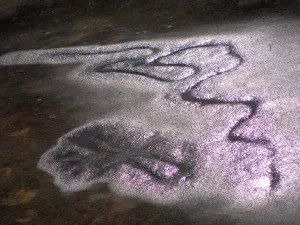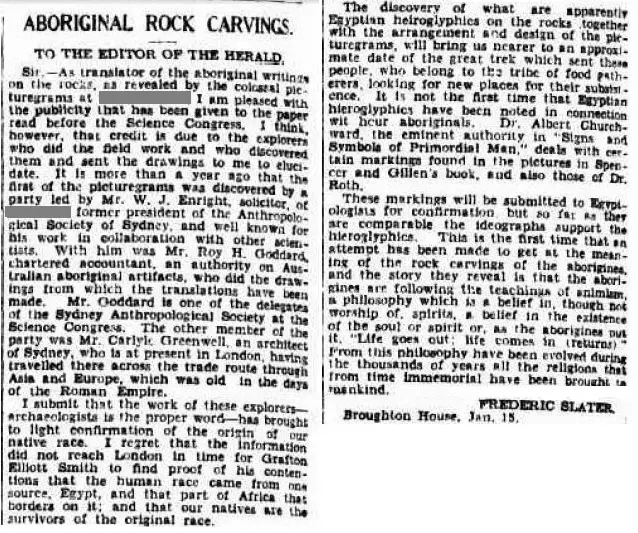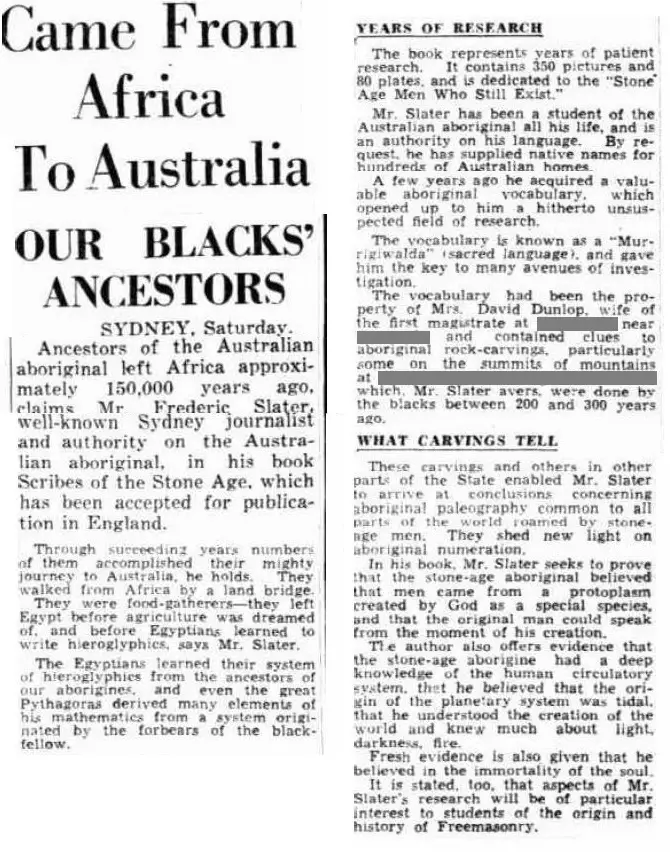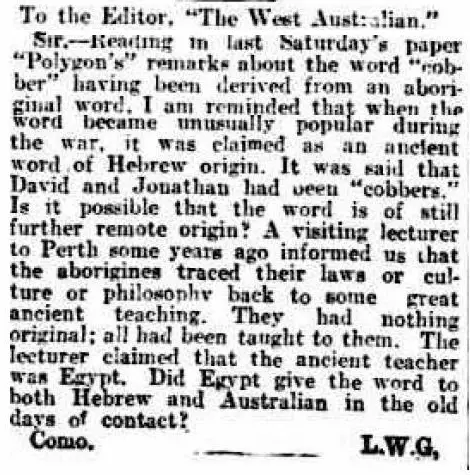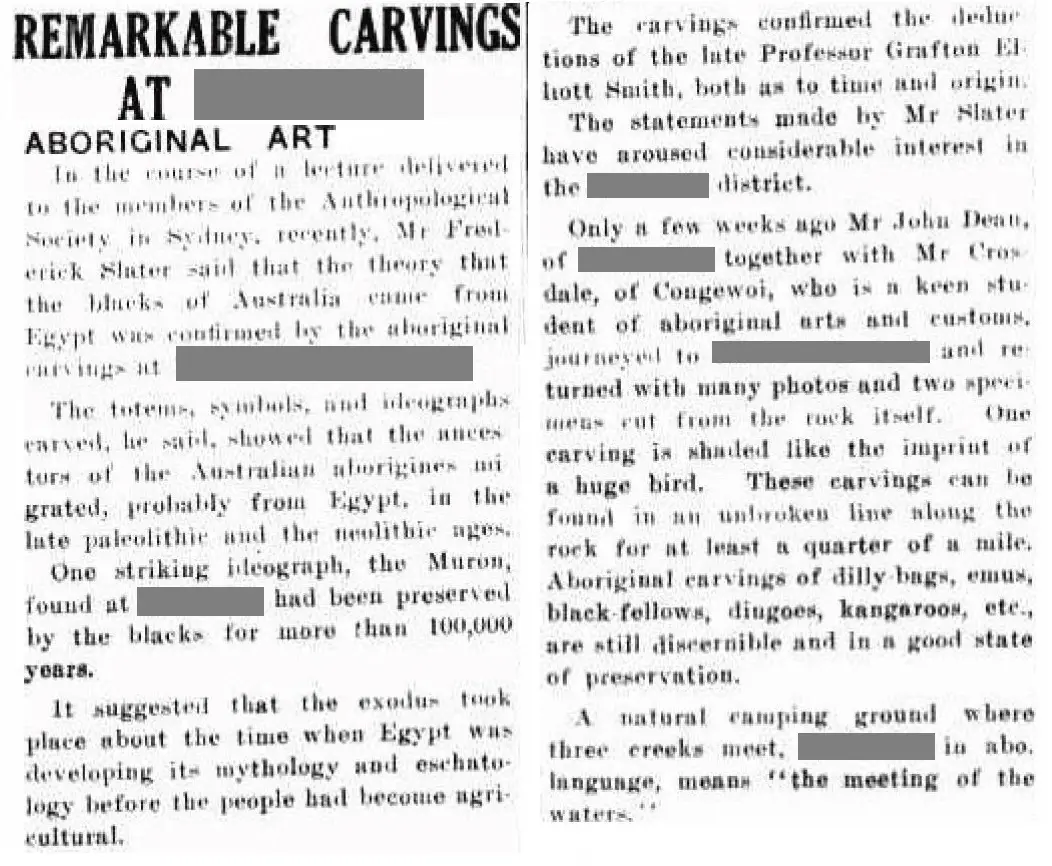By Steven Strong and Andy Whiteley
Contributing Writers for Wake Up World
Not for one second would we ever use the word conspiracy to describe what took place in Australia between 1937 and 1940; as accurate as it is, there is too much cynical baggage and condescension associated with this often used word.
Nevertheless, we can state with absolute confidence that the systematic theft of the Original peoples’ birthright and historical truths was sanctioned by the Australian government and perpetrated by agents who did their bidding. For all and intents and purposes, those in control acted like pirates. Agents and representatives of the ‘Commonwealth of Australia’ actively engaged in suppressing information that was, at the time, freely shared in mainstream media. This collusion eventually led to the destruction, by proxy and pressure, of some amazing archaeology that would undoubtedly have rewritten world pre-history.
Rather than “conspiracy”, let’s call it “com-piracy”.
Mainstream Media circa 1937
Originally we assumed that all talk of ancient Egyptians in Australia began in 1939 at the Standing Stones site. It wasn’t so. An historical researcher by the name of Erik Bower sent us a selection of press clippings from throughout the 1930’s, found in various historical archives, which openly discussed archaeology of a decidedly ancient Egyptian nature.
A report in the Sydney Morning Herald newspaper dated January 23, 1937 provided details of Frederic Slater’s (President of the Australian Archaeology Society) paper describing “colossal picturegrams” and symbols he felt were of ancient Egyptian inspiration.
Initially we were taken aback by these news clippings, not just because there was another “discovery of what are apparently Egyptian hieroglyphs” in Australia, but because of how widespread that knowledge was at the time. According to the report, Slater was “pleased with the publicity that has been given to the paper [that was] read before the Science Congress”. And adding weight to Slater’s claims, a stellar cast of the highest calibre was also involved in assisting Slater’s research.
He went on to describe how this amazing site was first found:
“… the first of the picturegrams was discovered by a party led by Mr. W. J. Enright… former president of the Anthropological Society of Sydney, and well known for his collaboration with other scientists. With him was Mr. Roy H. Goddard… an authority on Australian aboriginal (sic) artefacts, who did the drawings from which the translations were made…”
Now, these people are not hippies wondering through the bush in search of a cosmic connection to the scared Isiac spirit, nor are they rank amateurs. Including the President of the Australian Archaeology Society, elected to represent all archaeologists throughout the continent, these men were some of the best qualified academics in the country. Slater was so impressed with their qualifications and expertise, and confident in their findings, that he stated:
“I submit that the work of these explorers -archaeologists in the proper word- has brought to light confirmation of the origin of our native race”.
You can read the full article here.
[For reasons of respect and protection, I have omitted any specific references to this site’s location from this article as well as the archival news clippings provided].
The Hieroglyphs of the “Forbears of the Blackfellow”
According to an article in The Mail newspaper, Adelaide, October 23, 1937:
The ancestors of the Australian Aboriginal… left Egypt before agriculture was even dreamed of, and before Egyptians learned to write hieroglyphics, says Mr. Slater. The Egyptians learned their system of hieroglyphs from the ancestors of our aborigines (sic), and even the great Pythagoras derived many elements of his mathematics from a system originated by the forbears of the blackfellow.
Although in our opinion the reverse journey was actually travelled, Slater quite rightly believed that “our natives are the survivors of the original race” and determined that the ancestral link well and truly pre-dates the first hypothetical general African exodus of Homo sapien sapiens 60,000 years ago.
Slater’s underlying assumption – that the ancestors of the Original people simply walking out of Egypt and into Australia “approximately 150,000 years ago” by means of “a land bridge” – is now known to be false. At least one journey of over 100 kilometres across the ocean was required to reach Australia from its nearest south-east Asian vantage point. Nevertheless, it is understandable that Slater would presume the Egyptians to be more advanced and technologically savvy than the Original people, and thus the instigators of their cross-cultural contact. He was already aware that this ancient Egyptian influence had been found in rock carvings in other parts of the country, and previously investigated by other academics.
It is not the first time that Egyptian hieroglyphics have been noted in connection with our aboriginals (sic). Dr. Albert Churchward, the eminent authority in “Signs and Symbols of Primordial Man,” deals with certain markings…
For Slater, this recent discovery was the piece de resistance. The questions had been answered; an ancient Egyptian presence in Australia was unconditionally “confirmed by the aboriginal (sic) carvings at ****.”
In what was a precursor to the translations yet to be made by Slater, of the First Sacred Language at the Standing Stones found within 40 kilometres of Mullumbimby, he provides some specifics in relation to how he was able to decipher the combination or rock markings, shapes, lines, hand signs, senses, etc. that make up the First Language.
Mr. Slater has been a student of the Australian aboriginal (sic) all his life, and is an authority on his language. By request, he has supplied native names for hundreds of Australian homes.
A few years ago he acquired a valuable aboriginal (sic) vocabulary, which opened up to him a hitherto unsuspected field of research. The vocabulary is known as “Murrigiwalda” (sacred language), and gave him the key to many avenues of investigation…
You can read the full article here.
“What Carvings Tell”
(sub-heading from The Mail newspaper article, Adelaide, October 23, 1937)
Now it all starts to get rather radical, verging on utterly sensational….
Slater’s claims of what the hieroglyphs mean, and the fact that such observations were often published in mainstream press, was as promising as it eventually turned out to be sinister.
At this time in history, Original people were considered to be fauna (animals) under Australian ‘law’. Original people were virtually imprisoned in missions and reserves throughout Australia and were rarely if ever seen in the general public. Entry and exit to reserves was strictly supervised and the white managers had absolute control – and often very little empathy. The official government policy was designed to assimilate the Original people, both genetically and socially, by decimating their ancient culture and ‘breeding out’ their blood line with white genes. Perceived as primitive, naked, nomadic and uncivilized, carrying only stick and stone, the Original race had no public profile or defender n 1930s Australia.
Yet what Slater asserted in his book Scribes of the Stone Age, and what The Mail journalist reported, was in complete contrast to both the Original stereotype of the time and to any currently-held accounts of Australian pre-history.
Mr. Slater seeks to prove that the stone-age aboriginal (sic) believed that men came from a protoplasm created by God as special species, and that the original man could speak from the moment of his creation.
The author also offers evidence that the stone age aborigine (sic) had a deep knowledge of the circulatory system, that he believed that the origin of the planetary system was tidal, that he understood the creation of the world, and knew much about light, darkness and fire.
Fresh evidence is also given that he believed in the immortality of the soul.
At the time, many of these themes were assumed to be beyond the province of the Original intellect and Lore, so were surely challenging for conservative academics of the time. And these themes soon started to recur in further archaeology, reappearing just two years later at the Standing Stones site. But despite all evidence, the status quo thinking prevailed and the systemic cultural persecution (and underestimation) of the Original people continued in defiant ignorance.
Interestingly, in the last paragraph of The Mail article is the suggestion of Original origins for another ‘sacred’ order, one thought to be founded as a bastion of white male secrecy: Freemasonry.
“It is stated too, that aspects of Mr. Slater’s research will be of particular interest to students of the origin and history of Freemasonry.”
Of acute and “particular interest” to Professor A.P. Elkin (first Professor of Anthropology at Sydney University) was that six years before this seminal Egyptian site with Freemason undertones was found and openly discussed in the public arena, he stood in the Kimberleys (WA) next to Original men and women who had never been in direct contact with whites – and from the time he was greeted, nothing went to script. The “tribal Elders greeted him with ancient Masonic hand signs”, and “many of the words spoken were of Egyptian origin” – enigmas Professor Elkin was never able to resolve.
Although just reporting this event took some degree of courage, Professor Elkin’s seemingly contradictory interactions with the Original people of the Kimberleys opens up many doors of investigation through which he never dared to venture.
Yet another off-centre indicator of an ancient Egyptian presence in the area was an article appearing in The West Australian newspaper on August 29, 1931. The correspondent reminisced that “a visiting professor to Perth some years ago informed us that the aborigines (sic) traced their laws or cultures back to some great ancient teaching. The lecturer claimed that the ancient teacher was Egypt”. He went on to make semantic comparison of the word “cobber” which was “derived from an aboriginal word”.
The correspondent also noted that “it was claimed as an ancient word of Hebrew origin. It was said that David and Johnathon had been cobbers”. He then went on to pose the question “Did Egypt give the word to both Hebrew and Australian in the old days of contact?”
No, but he was close.
Excavating at the Edges
Whether or not there was a linguistic connection is a secondary consideration. What this small sampling amply illustrates was that during the 1930’s the academic and journalistic climates were very different to those of today; there was real and meaningful anthropology, archaeology and public discussion conducted, much of it substantiating (or at the very least suggesting) some sort of contact between ancient Egyptians and Australians. As to who was the initiator is now the only question open to conjecture; what is no longer in contention is that ancient Egyptians were here.
In Slater’s mind, the site at **** is the genuine article. We absolutely agree. Within a minute of standing on the site for the first time, with no prior knowledge of any previous research or theory, we were absolutely convinced we had seen Original/Egyptian engravings, and time has done nothing but reinforce that belief.
But alas, time hasn’t been so kind to that same sacred site. Although Slate and his academic colleagues (and others) were clearly taken with this site, despite their good intentions, they showed an appalling understanding of Original lore and sensibilities, and they actually removed large slabs of rock-hard evidence from the site and placed it into the abyss of private artefact storage. As reported in the Singleton Argus newspaper on March 19, 1937, “only a few weeks ago Mr. John Deans… together with Mr. Crossdale… who is a keen student of aboriginal (sic) arts and customs, journeyed to the **** and returned with many photos and two specimen’s cut from the rock itself”.
Having visited this site, we would replace the word “specimens” with “two enormous slabs”, and sigh at the abject desecration – as we did at the time.
Despite its desecration, the academic and public response to news of this site was so far all good; detailed papers, receptive conferences, academics of the highest calibre, positive mainstream discussions, and all without a hint of censorship or overt interference on the part of government. By the end of 1937, there was a growing consensus of an ancient Egyptian presence, led by arguably the top two Australian experts of Egyptology and Original language united in archaeology and philosophy. Indeed, the tide seemed to be turning in their favour.
Bad Moon Rising
Three years later, it was all over. The most important archaeological site in Australia, which Slater dubbed “Australia’s Stonehenge”, was destroyed in 1940 as a direct result of government intervention. Then, with Australia committing all its resources and attention to the overseas battle of WWII, any talk of Egypt (and indeed archaeology in general) was soon dispensed of, not only during the war but for the next 70 odd years.
What happened? How could all of this adventurous academic consensus evaporate into a void? There has been no official interest in our obvious Egyptian history since the war, and today, anyone who speaks of an ancient Egyptian presence in Australia is ridiculed as a nutcase. And there is a reason for that – it is deliberate.
According to archives of Frederic Slater’s personal correspondence, it seems that soon after going public in 1937 there began an orchestrated swell of opposition against him. The tone in his personal letters began positively during his initial research, but as his findings evolved and news of this archaeology spread into the public arena, his letters began to name those acting in opposition to his work, and colleagues who caved in to the pressure. As the chronology of his correspondence progresses, Slater expresses suspicions and frustrations, and finally lists a series of events (and participants) that led up to the government issuing threats against the landholder, leaving him backed into a corner with no way to save his land but to destroy the sacred site. Which he regretfully did.
By forcing the site’s destruction and cultivating a culture of academic bullying against those who delve into the sacred history of this land, sadly, the Australian government won the battle in 1937. But in 2014, the evidence is clear, and despite the attempts of government (then and now) the true history of this ancient land will not be suppressed.
The notion that the Original people of ancient Australia experienced cross-cultural interactions before the European settlement of the late 1700s is a simple and reasonable notion. Given that their civilization is (arguably) hundreds of thousands of years old, such interaction was always probable, and the archaeological evidence found around the country proves it conclusively. But in Australian academic and government circles, this fact is still too challenging to the ‘Aussie’ mythology that surrounds white settlement in Australia. To realistically re-assess the ancient history of this continent would contradict the excrement that passes for text-book history in this country, and require the Australian government to admit that in the late 1700’s, the British unlawfully invaded the land of an ancient civilization, dispossessed them of their land, undermined their culture and technology, erased their history, implemented a program of ‘breeding out’, and pretended like nothing ever happened.
Next Time, on ‘Com-piracy’….
In the follow up to this article, we will examine Frederic Slater’s blow-by-blow battle with mainstream conservatives who rallied against him and his dwindling base of supporters. Throughout 1939 Slater became more concerned and candid in his commentary, as he began to realise that his attempts to thwart the theft of heritage and protect the integrity of the Standing Stones site were doomed to fail. As is so often the case, we will show that the forces of deception within government were working to maintain the status quo, without conscience or vision.
For now, the com-piracy continues.
About the authors:
Steven Strong is an Australian-based researcher, author and former high school teacher. Evan Strong is a researcher, historian and author with a degree in the Social Sciences. Their work is to explore the ancient story of the Original people, a narrative that was almost lost to aggressive European colonisation.
Andy Whiteley an average 40-something from Melbourne Australia who, like many people, “woke up” and realized everything isn’t what it seems. Since then, he feels blessed to be a part of Wake Up World and its amazing community of readers.
Additional research by Erik Bower.
This article © Wake Up World.

If you've ever found value in our articles, we'd greatly appreciate your support by purchasing Mindful Meditation Techniques for Kids - A Practical Guide for Adults to Empower Kids with the Gift of Inner Peace and Resilience for Life.
In the spirit of mindfulness, we encourage you to choose the paperback version. Delve into its pages away from screen glare and notifications, allowing yourself to fully immerse in the transformative practices within. The physical book enriches the learning process and serves as a tangible commitment to mindfulness, easily shared among family and friends.
Over the past few years, Wake Up World has faced significant online censorship, impacting our financial ability to stay online. Instead of soliciting donations, we're exploring win-win solutions with our readers to remain financially viable. Moving into book publishing, we hope to secure ongoing funds to continue our mission. With over 8,500 articles published in the past 13 years, we are committed to keeping our content free and accessible to everyone, without resorting to a paywall.

